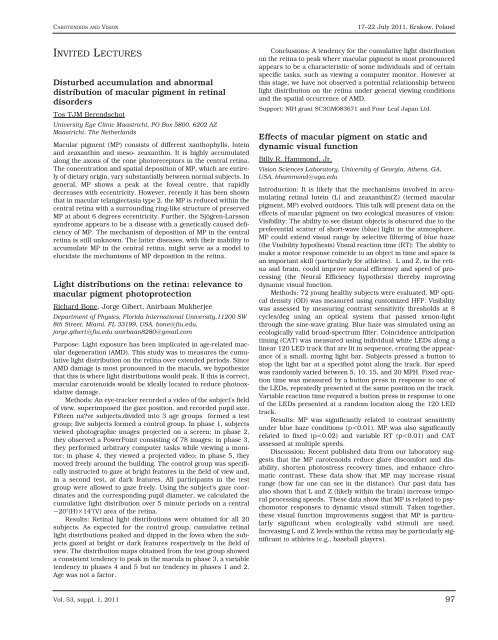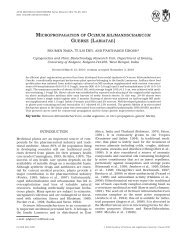ACTA BIOLOGICA CRACOVIENSIA
ACTA BIOLOGICA CRACOVIENSIA
ACTA BIOLOGICA CRACOVIENSIA
Create successful ePaper yourself
Turn your PDF publications into a flip-book with our unique Google optimized e-Paper software.
CAROTENOIDS AND VISION<br />
INVITED LECTURES<br />
Disturbed accumulation and abnormal<br />
distribution of macular pigment in retinal<br />
disorders<br />
Tos TJM Berendschot<br />
University Eye Clinic Maastricht, PO Box 5800, 6202 AZ<br />
Maastricht, The Netherlands<br />
Macular pigment (MP) consists of different xanthophylls, lutein<br />
and zeaxanthin and meso- zeaxanthin. It is highly accumulated<br />
along the axons of the cone photoreceptors in the central retina.<br />
The concentration and spatial deposition of MP, which are entirely<br />
of dietary origin, vary substantially between normal subjects. In<br />
general, MP shows a peak at the foveal centre, that rapidly<br />
decreases with eccentricity. However, recently it has been shown<br />
that in macular telangiectasia type 2, the MP is reduced within the<br />
central retina with a surrounding ring-like structure of preserved<br />
MP at about 6 degrees eccentricity. Further, the Sjögren-Larsson<br />
syndrome appears to be a disease with a genetically caused deficiency<br />
of MP. The mechanism of deposition of MP in the central<br />
retina is still unknown. The latter diseases, with their inability to<br />
accumulate MP in the central retina, might serve as a model to<br />
elucidate the mechanisms of MP deposition in the retina.<br />
Light distributions on the retina: relevance to<br />
macular pigment photoprotection<br />
Richard Bone, Jorge Gibert, Anirbaan Mukherjee<br />
Department of Physics, Florida International University,11200 SW<br />
8th Street, Miami, FL 33199, USA, bone@fiu.edu,<br />
jorge.gibert@fiu.edu anirbaan8280@gmail.com<br />
Purpose: Light exposure has been implicated in age-related macular<br />
degeneration (AMD). This study was to measures the cumulative<br />
light distribution on the retina over extended periods. Since<br />
AMD damage is most pronounced in the macula, we hypothesize<br />
that this is where light distributions would peak. If this is correct,<br />
macular carotenoids would be ideally located to reduce photooxidative<br />
damage.<br />
Methods: An eye-tracker recorded a video of the subject's field<br />
of view, superimposed the gaze position, and recorded pupil size.<br />
Fifteen na?ve subjects,divided into 3 age groups formed a test<br />
group; five subjects formed a control group. In phase 1, subjects<br />
viewed photographic images projected on a screen; in phase 2,<br />
they observed a PowerPoint consisting of 78 images; in phase 3,<br />
they performed arbitrary computer tasks while viewing a monitor;<br />
in phase 4, they viewed a projected video; in phase 5, they<br />
moved freely around the building. The control group was specifically<br />
instructed to gaze at bright features in the field of view and,<br />
in a second test, at dark features. All participants in the test<br />
group were allowed to gaze freely. Using the subject's gaze coordinates<br />
and the corresponding pupil diameter, we calculated the<br />
cumulative light distribution over 5 minute periods on a central<br />
~20°(H)×14°(V) area of the retina.<br />
Results: Retinal light distributions were obtained for all 20<br />
subjects. As expected for the control group, cumulative retinal<br />
light distributions peaked and dipped in the fovea when the subjects<br />
gazed at bright or dark features respectively in the field of<br />
view. The distribution maps obtained from the test group showed<br />
a consistent tendency to peak in the macula in phase 3, a variable<br />
tendency in phases 4 and 5 but no tendency in phases 1 and 2.<br />
Age was not a factor.<br />
Vol. 53, suppl. 1, 2011<br />
17–22 July 2011, Krakow, Poland<br />
Conclusions: A tendency for the cumulative light distribution<br />
on the retina to peak where macular pigment is most pronounced<br />
appears to be a characteristic of some individuals and of certain<br />
specific tasks, such as viewing a computer monitor. However at<br />
this stage, we have not observed a potential relationship between<br />
light distribution on the retina under general viewing conditions<br />
and the spatial occurrence of AMD.<br />
Support: NIH grant SC3GM083671 and Four Leaf Japan Ltd.<br />
Effects of macular pigment on static and<br />
dynamic visual function<br />
Billy R. Hammond, Jr.<br />
Vision Sciences Laboratory, University of Georgia, Athens, GA,<br />
USA, bhammond@uga.edu<br />
Introduction: It is likely that the mechanisms involved in accumulating<br />
retinal lutein (L) and zeaxanthin(Z) (termed macular<br />
pigment, MP) evolved outdoors. This talk will present data on the<br />
effects of macular pigment on two ecological measures of vision:<br />
Visibility: The ability to see distant objects is obscured due to the<br />
preferential scatter of short-wave (blue) light in the atmosphere.<br />
MP could extend visual range by selective filtering of blue haze<br />
(the Visibility hypothesis) Visual reaction time (RT): The ability to<br />
make a motor response coincide to an object in time and space is<br />
an important skill (particularly for athletes). L and Z, in the retina<br />
and brain, could improve neural efficiency and speed of processing<br />
(the Neural Efficiency hypothesis) thereby improving<br />
dynamic visual function.<br />
Methods: 72 young healthy subjects were evaluated. MP optical<br />
density (OD) was measured using customized HFP. Visibility<br />
was assessed by measuring contrast sensitivity thresholds at 8<br />
cycles/deg using an optical system that passed xenon-light<br />
through the sine-wave grating. Blue haze was simulated using an<br />
ecologically valid broad-spectrum filter. Coincidence anticipation<br />
timing (CAT) was measured using individual white LEDs along a<br />
linear 120 LED track that are lit in sequence, creating the appearance<br />
of a small, moving light bar. Subjects pressed a button to<br />
stop the light bar at a specified point along the track. Bar speed<br />
was randomly varied between 5, 10, 15, and 20 MPH. Fixed reaction<br />
time was measured by a button press in response to one of<br />
the LEDs, repeatedly presented at the same position on the track.<br />
Variable reaction time required a button press in response to one<br />
of the LEDs presented at a random location along the 120 LED<br />
track.<br />
Results: MP was significantly related to contrast sensitivity<br />
under blue haze conditions (p












